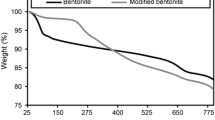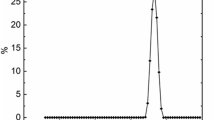Abstract
Despite the various uses of hydrogels, one of their weaknesses is the poor gel strength. To overcome this restriction, the current study has focused on simultaneously employing an interpenetrating polymer network (IPN) structure and nanocomposite hydrogels. Through this approach, the influence of nanofiller in the single network and IPN hydrogel properties was also studied in detail. For this purpose, a novel full interpenetrating polymer network (IPN) hydrogel nanocomposite based on 2-acrylamido-2-methylpropane sulfonic acid (AMPS)/acrylic acid (AA)–sodium acrylate (AANa) was synthesized in two steps through a facile solution polymerization with incorporation of modified bentonite (MBE) as nanofiller. The prepared modified nanoplatelets, MBE, were characterized by XRD and FT-IR. The effect of MBE content on the chemical structure of single network and full IPN hydrogels was studied by FT-IR, XRD and DSC. The obtained swelling capacity for these IPN hydrogel nanocomposites was generally decreased by incorporation of MBE nanosheets. So that the lowest water absorbency (about 25 g/g) was obtained for the nanocomposite hydrogels containing 10 wt% of MBE. Moreover, rheological method and tensile test were used to investigate the mechanical properties of hydrogels. The results indicated that by increasing the MBE content in the IPN hydrogel network, the storage modulus of the prepared nanocomposite showed a totally different behavior compared to that of single network hydrogel. It is worth noting that IPN hydrogel containing only 1 % nanoclay showed the highest Young’s modulus in comparison to that of other prepared hydrogels. On the other hand, the highest elongation (about 600 %) was observed for MBE-free IPN hydrogel matrix. Thus, fascinating elastic responses and full recovery after a few minutes of unloading indicate that the synthesized IPN nanocomposite hydrogel exhibits admissible mechanical strength, which makes it a promising candidate for various applications.









Similar content being viewed by others
References
Buchholz FL, Peppas NA (1994) Superabsorbent polymers science and technology, ACS symposium Series, 573. American Chemical society, Washington, DC
Peppas NA (1986) Hydrogels in medicine and pharmacy. CRC Press, Boca Raton
Hoare TR, Kohane DS (2008) Hydrogels in drug delivery: progress and challenges. Polymer 49:1993–2007
Lee KY, Mooney DJ (2001) Hydrogels for tissue engineering. Chem Rev 101:1869–1879
Lee SW, Wang E, Desai MS (2013) Light-Controlled Graphene-Elastin Composite Hydrogel Actuators. Nano Lett 13(6):2826–2830
Gong JP (2010) Why are double network hydrogels so tough? Soft Matter 6(12):2583–2590
Okumura Y, Ito K (2001) The polyrotaxane gel: a topological gel by figure-of-eight cross-links. Adv Mater 13:485–487
Ito K (2012) Novel entropic elasticity of polymeric materials: why is slide-ring gel so soft? Polym J 44:38–41
Ma S, Liu M, Chen Zh (2004) Preparation and properties of a salt-resistant superabsorbent polymer. J Appl Polym Sci 93:2532–2541
Huang T, Xu HG, Jiao KX, Zhu LP, Brown HR, Wang HL (2007) A novel hydrogel with high mechanical strength: a macromolecular microsphere composite hydrogel. Adv Mater 19(12):1622–1626
Haraguchi K (2011) Stimuli-responsive nanocomposite gels. Colloid Polym Sci 289:455–473
Schexnailder P, Schmidt G (2009) Nanocomposite polymer hydrogels. Colloid Polym Sci 287:1–11
Liu R, Liang S, Tang XZh, Yan D, Li X, Yu ZhZh (2012) Tough and highly stretchable graphene oxide/polyacrylamide nanocomposite hydrogels. J Mater Chem 22:14160–14167
Haraguchi K (2008) Nanocomposite hydrogels. Curr Opin Solid State Mat Sci 11:47–54
Gong JP, Katsuyama Y, Kurokawa T, Osada Y (2003) Double-network hydrogels with extremely high mechanical strength. Adv Mat 15:1155–1158
Hu J, Kurokawa T, Hiwatashi K, Nakajima T, Wu ZL, Liang SM, Gong JP (2012) Structure optimization and mechanical model for microgel-reinforced hydrogels with high strength and toughness. Macromolecules 45(12):5218–5228
Myung D, Waters D, Wiseman M, Duhamel PE, Noolandi J, Ta ChN, Frank CW (2008) Progress in the development of interpenetrating polymer network hydrogels. Polym Adv Technol 19:647–657
Wang Q, Hou RX, Cheng YJ, Fu J (2012) Super-tough double network hydrogels reinforced by covalently compositing with silica-nanoparticles. Soft Matter 8:6048–6056
Stefanescu EA, Stefanescu C, Daly WH, Schmidt G, Negulescu LI (2008) Hybrid polymer–clay nanocomposites: a mechanical study on gels and multilayered films. Polymer 49:3785–3794
Lin WC, Marcellan A, Hourdet D, Creton C (2011) Effect of polymer–particle interaction on the fracture toughness of silica filled hydrogels. Soft Matter 7(14):6578–6582
Wu CJ, Gaharwar AK, Chan BK, Schmidt G (2011) Mechanically tough pluronic F127/Laponite nanocomposite hydrogels from covalently and physically cross-Linked networks. Macromolecules 44(20):8215–8224
Huang X, Xu S, Zhong M, Wang J, Feng S, Shi R (2009) Modification of Na-bentonite by polycations for fabrication of amphoteric semi-IPN nanocomposite hydrogels. Appl Clay Sci 42(3):455–459
Helvacıoğlu E, Aydın V, Nugay T, Nugay N, Uluocak BG, Şen S (2011) High strength poly (acrylamide)-clay hydrogels. J Polym Res 18(6):2341–2350
Yongmei J, Yang L, Yun M, Xiaoli L, Zongyi Q, Meifang Zh, Adler HJ (2008) Novel interpenetrating networks (IPNs) hydrogels prepared in Situ by liquid-phase photopolymerization. Macromol Symp 264:95–99
Peak ChW, Jonathan JW, Schmidt G (2013) A review on tough and sticky hydrogels. Colloid Polym Sci 291(9):2031–2047
Djonlagić J, Žugic´ D, Petrović Z (2012) High strength thermoresponsive semi-IPN hydrogels reinforced with nanoclays. J Appl Polym Sci 124(4):3024–3036
Zhou Ch, Wu Q (2011) A novel polyacrylamide nanocomposite hydrogel reinforced with natural chitosan nanofibers. Colloids Surf B Biointerf 84:155–162
Ramazani-Harandi MJ, Zohuriaan-Mehr MJ, Yousefi AA, Ershad Langroudi A, Kabiri K (2006) Rheological determination of the swollen gel strength of superabsorbent polymer hydrogels. Polym Test 25:470–474
Starodoubtsev SG, Lavrentyeva EK, Khokhlov AR, Allegra G, Famulari A, Meille SV (2006) Mechanism of smectic arrangement of montmorillonite and bentonite clay platelets incorporated in gels of poly (acrylamide) induced by the interaction with cationic surfactants. Langmuir 22(1):369–374
Løvoll G, Sandnes B, Méheust Y et al (2005) Dynamics of water intercalation fronts in a nano-layered synthetic silicate: a synchrotron X-ray scattering study. Physica B 370(1):90–98
Rehab A, Akelah A, Agag T, Shalaby N (2007) Polyurethane-nanocomposite materials via in situ polymerization into organoclay interlayers. Polym Adv Technol 18(6):463–471
Pourjavadi A, Kheirabadi M, Zohuriaan-Mehr MJ, Kabiri K (2009) Antipolyelectrolyte superabsorbing nanocomposites: synthesis and properties. J Appl Polym Sci 114(6):3542–3547
Kabiri K, Lashani S, Zohuriaan-Mehr MJ, Kheirabadi M (2011) Super alcohol-absorbent gels of sulfonic acid-contained poly (acrylic acid). J Polym Res 18(3):449–458
Thakur A, Wanchoo RK, Singh P (2012) Hydrogels of Poly (acrylamide-co-acrylic acid): in-vitro Study on Release of Gentamicin Sulfate. Chem Biochem Eng Q 25(4):471–482
Narender A, Hussain K, Sathaiah G (2011) Dielectric relaxation behaviour of acrylonitrile and 2-acrylamido 2-methyle propane sulphonic acid copolymers. Int J Eng Sci 3(12):8514–8518
Suri S, Schmidt CE (2009) Photopatterned collagen–hyaluronic acid interpenetrating polymer network hydrogels. Acta Biomater 5(7):2385–2397
Tominaga T, Osada Y, Gong JP (2009) Structural approaches on the toughness in double network hydrogels. Chemomechanical instabilities in responsive materials. Springer, Netherlands, pp 117–138
Tirumala VR, Tominaga T, Lee S, Butler PD, Lin EK, Gong JP, Wu WL (2008) Molecular model for toughening in double-network hydrogels. J Phys Chem B 112(27):8024–8031
Brown HR (2007) A model of the fracture of double network gels. Macromolecules 40(10):3815–3818
Cipriano BH, Banik SJ, Sharma R, Rumore D, Hwang W, Briber RM, Raghavan SR (2014) Superabsorbent hydrogels that are robust and highly stretchable. Macromolecules 47(13):4445–4452
Quarini J, Shire S (2007) A review of fluid-driven pipeline pigs and their applications. Proc Inst Mech Eng Part E J Process Mech Eng 221(1):1–10
Author information
Authors and Affiliations
Corresponding author
Rights and permissions
About this article
Cite this article
Kheirabadi, M., Bagheri, R. & Kabiri, K. Swelling and mechanical behavior of nanoclay reinforced hydrogel: single network vs. full interpenetrating polymer network. Polym. Bull. 72, 1663–1681 (2015). https://doi.org/10.1007/s00289-015-1362-z
Received:
Revised:
Accepted:
Published:
Issue Date:
DOI: https://doi.org/10.1007/s00289-015-1362-z




